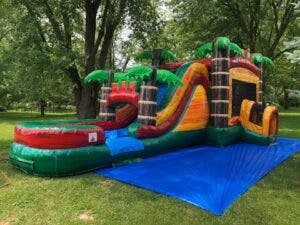Retail? Crossover? Commercial? Which Inflatables Do I Want?
When you first set off on your journey into the realm of inflatable bouncers, you’ll find yourself faced with a whole lot of options.
There are bounce houses. Bounce house slide combos. Inflatable water slides. Inflatable obstacle courses. And all manner of other inflatable games and inflatable bouncers, too. And they come in three very different tiers of qualities: retail inflatables, Vinyl Crossover™ inflatables, and commercial inflatables.
Figuring out which style of inflatable bouncers you want is of course a personal preference. But those three quality tiers—retail, crossover, and commercial—may be a little confusing to navigate at first. So let’s explore all three tiers of these products and explain what each is best for. And please note, we don’t sell retail inflatables. We just want you to make an informed decision.
Retail Inflatables: Basic Bouncers and Slides
The cheapest bounce houses, and the most popular with consumers buying instead of renting, are retail inflatables. You’ll find these at Amazon, Walmart, Target, Overstock.com, and all sorts of other popular websites.
At first glance, their price tags can be quite alluring. You might pay anywhere from $100 to $500 for a retail inflatable, and that’s a significant price difference when you compare them with Pogo’s Vinyl Crossover™ inflatables and commercial inflatables.
Why are they so cheap? It mostly boils down to their material quality. And as in all avenues of life, you end up getting what you pay for.
Retail inflatables usually use either nylon or polyester. Nylon is usually stronger, while polyester is more resistant to abrasion. But neither material holds a candle to vinyl in terms of strength, abrasion resistance, tear resistance, or general longevity.
Polyester is often billed as “Oxford fabric,” and usually accompanied by something like 400D, 600D, or 800D, or something in that range. This denotes the overall weight and strength of the polyester. The “D” is for “denier,” a unit of measure for fiber weight and thickness. For instance, a 420D bounce house will generally not last as long as a 600D bounce house, due to its lighter material.
Retail Inflatable Pros and Cons
The Pros:
- Very cheap price-wise compared to vinyl crossovers or commercial inflatables
- Ideal for toddlers and children under the ages of five or six
- Small footprint; generally won’t use much space
- Good if you’re only using it infrequently; every other weekend, or once or twice per month
The Cons:
- Won’t last nearly as long as vinyl inflatables. It might not even survive one full summer.
- Rips, tears, and other damage cannot be patched as easily (some of these cheaper materials can’t be patched at all)
- Not as fun for older kids
- Adults should not use these at all
- Little or no resale value; You'll be stuck with it once your kids grow out of it.
- Severely limited maximum weight supported
Let’s Meet Pogo’s Vinyl Crossover™ Inflatables
Exclusive to Pogo Bounce House are our Vinyl Crossover inflatables. These consumer grade inflatable bouncers bridge the gap between retail inflatables and commercial inflatables. And they’re the best solution for families expecting more from their bounce house, inflatable water slide, or other inflatable bouncer.
Vinyl crossovers use PVC vinyl similar (or even identical) to the commercial grade vinyl used in our commercial inflatables. They use multiple layers of material at stress areas that are double, triple, or even quadruple stitched. Most units include extra slack at 90° seams to avoid the most common tears and rips inflatable games are often subjected to.
Sidewalls are made using finger-safe ripstop PVC netting, which grants improved visibility into the unit without compromising safety. And this same style of netting goes into our No-Jump Top™ technology, which ensures children are always properly, safely seated when using inflatable slides.
Phrased another way: these inflatable games are built almost as tough as their commercial inflatable siblings. But their pricing is kept affordable enough that families can buy them for the backyard.
Vinyl Crossover inflatables cost anywhere from $600 to $1400 for bigger inflatable games like bounce houses and the like. Air frame games and other smaller interactive inflatable games typically run between $300 and $600.
[product ids="3171,3431,3421"]
Vinyl Crossover Inflatable Pros and Cons
The Pros:
- Significantly more durable and longer-lasting than retail inflatables; PVC vinyl is five times stronger than traditional retail nylon
- Better suited for kids ages six and up, teenagers, and young adults
- Ideal for more frequent use than retail inflatables can safely handle; you can set these up weekly or even daily, so long as they’re properly maintained, cleaned, and cared for
- PVC vinyl can be easily repaired
- Higher maximum weight limits than retail units
- Can be resold if it’s taken care of properly; if your kids grow out of your Vinyl Crossover, you can resell it and let another family enjoy it
- Air blower, inflatable stakes, heavy duty storage bag, and a repair kit are all included
The Cons:
- Not intended for use as a rental unit
- Not large enough for most adults to enjoy
- Uses more yard space than smaller, simpler retail inflatables
- These inflatable games are quite heavy and require two people to move around safely (we also recommend buying a hand truck or dolly)
- Vinyl Crossover inflatables can last a very long time, but won’t last nearly as long as a commercial inflatable
Last but Not Least, the Big Dogs: Commercial Inflatables
Try to imagine a tiny smart car sitting next to a Ferrari. Or a little mall train beside a real one. Or that little 27” television your parents had when you were a kid, versus the 60” LED behemoth you or someone you know has in their home today.
That’s pretty much the difference between a retail inflatable and a commercial one.
 Commercial inflatables are designed and built to be high quality and tough as nails. They use multiple layers of heavy duty commercial vinyl that can hold up to rigorous usage. Their seams are heat welded and boast double to quadruple stitching, wildly enhancing their durability. If these inflatables were movie stars, we’d name them Arnold Sylvester VanGibwillisford. We know we’re missing some 80’s action movie stars in there, but let’s move along.
Commercial inflatables are designed and built to be high quality and tough as nails. They use multiple layers of heavy duty commercial vinyl that can hold up to rigorous usage. Their seams are heat welded and boast double to quadruple stitching, wildly enhancing their durability. If these inflatables were movie stars, we’d name them Arnold Sylvester VanGibwillisford. We know we’re missing some 80’s action movie stars in there, but let’s move along.
Driving the quality home even further, each of our commercial inflatables has been field-tested and battle-hardened. We rent all of our inflatable games out to test them thoroughly in real rental environments first, before selling them to you.
The end result? Commercial inflatables built from the bottom up for serious, heavy duty use in the rental business. These are built to be loaded onto a truck, driven to a party, set up, run for 12 hours straight, and then packed up and brought home.
Commercial inflatable bouncers are designed to work as rental units and in “workhorse settings.” If you need it for a church group, a family entertainment center, a carnival, etc., this is the way to go. They have tremendous resale value, too. But commercial inflatables are honestly overkill for most families.
[product ids="7207,4777,2084"]
Commercial Inflatables Pros and Cons
The Pros:
- Easily and by far the most durable and toughest of the three tiers of inflatables
- Lots of open space to bounce and play, with some inflatables boasting features like climbing walls and other obstacles
- Perfect for rentals and recurring outdoor kids events
- Can be used frequently; great if you plan on setting it up several times per week, or even daily
- Adults can play in some (if not most) commercial inflatables
- Our commercial inflatables ship with everything you need, include air blowers, stakes, a repair kit, safety signs, and more
- Accommodates higher maximum weight limits
- Can be repaired multiple times without compromising structural integrity
The Cons:
- Expensive: Commercial bounce houses, inflatable water slides, bounce slide combos, and inflatable obstacle courses range anywhere from $1000 to $8000 or even more. Some inflatable obstacle course packages can cost upwards of $20,000!
- Large, cumbersome, heavy, and difficult (if not impossible) for one person to set up. Some commercial inflatables can weigh as much as 800 pounds or more. Use of a heavy duty hand truck or dolly is pretty much mandatory
- Families and smaller organizations would probably be better served by a smaller Vinyl Crossover inflatable
- Many have a larger footprint requiring lots of open space
In Conclusion
 Which option is best for you? Would you be best off with a retail inflatable, a Vinyl Crossover inflatable, or a commercial inflatable? At the end of the day, it really boils down to who is using it, how they’re using it, when they’re using it, and why they’re using it.
Which option is best for you? Would you be best off with a retail inflatable, a Vinyl Crossover inflatable, or a commercial inflatable? At the end of the day, it really boils down to who is using it, how they’re using it, when they’re using it, and why they’re using it.
If you haven’t done so already, revisit those pros and cons we listed off earlier and think about them objectively. What are your goals? What are your expectations for the inflatable games you’re buying? How long do you expect to be using this game? And if you’re looking at vinyl crossover or commercial inflatables, how old will your kids be in four or five years? Will they still be young enough to enjoy it?
We hope this guide helps you find the perfect inflatable bouncers for you and your family to enjoy. But if it doesn’t, please feel free to comment below or give us a call today at 716-566-5806. Our inflatable experts would love the opportunity to discuss your needs and help you find the best bounce house, inflatable water slide, bounce slide combo, air frame game, or inflatable obstacle course to fit your plans and your budget.

